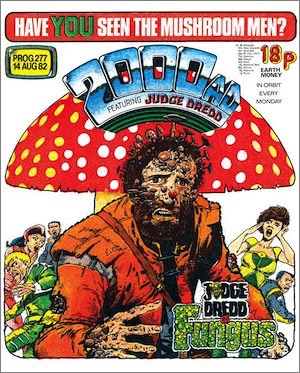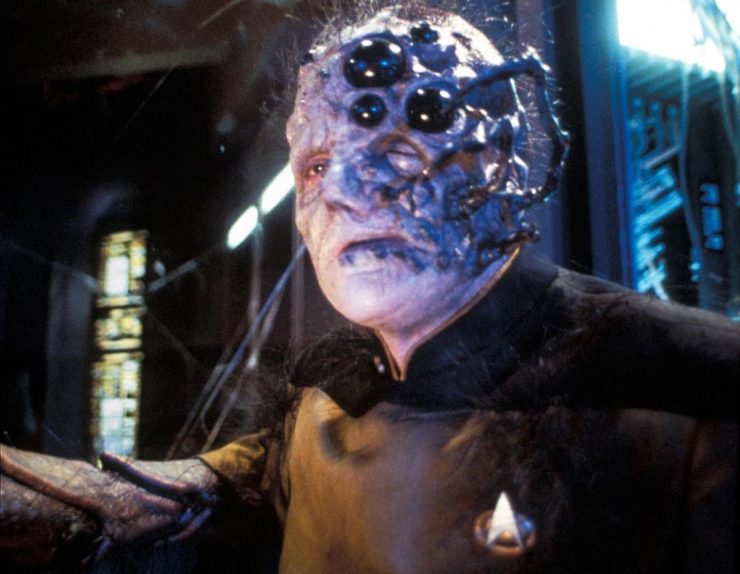The science fiction genre is endlessly creative, but that creatively isn’t only limited to cool future technologies and fantastical alien creatures. Science fiction is also rich with inventively horrible diseases, some of which exist light years away in the depths of fictional solar systems, while others have made their way to Earth. Either way, you’ll be glad these dreadful diseases have been plucked from the imagination and exist only on the page and screen. Buckle up—some of these are downright horrifying…
The Pax from Serenity (2005)
In the Firefly universe, Reavers are a nightmarish group who torture and eat anyone they come across. Their existence is denied by the Alliance and brushed off as the stuff of legend by people on the core planets, but those who live on the fringes, like the crew of Serenity, know better. The episodes “Serenity” and “Bushwacked” establish the Reavers as real-life boogeymen of the ‘Verse, but little is known about their origins. The truth about the sadistic space cannibals is finally revealed in the movie Serenity.
After traveling to the planet Miranda, Mal and company find everyone dead and a recording by Dr. Caron explaining what happened. The Alliance released an experimental chemical, G-23 Paxilon Hydrochlorate, known as the Pax, into the atmosphere to calm the population and eliminate aggression. However, it pacified people to such a degree that they stopped doing anything, including eating. But 0.1% of the population had the opposite reaction to the virus, turning into the aggressive Reavers who now stalk the outskirts of the star system. For the victims of the Pax, either outcome is incredibly grim.
The Andromeda Strain from The Andromeda Strain (1969)

Michael Crichton’s techno-thriller The Andromeda Strain taps into the fear that humanity is woefully unprepared for the unknown dangers of space. The novel begins with a military satellite—one designed to capture extra-terrestrial microorganisms for use as bioweapons—falling to earth near the town of Piedmont, Arizona. Soon afterwards almost every resident dies from nearly instantaneous blood clotting, all except for an old man and baby. This triggers Project Wildfire, which sees a group of scientists working together in a top secret research facility in order to figure out what, exactly, has hitched a ride to Earth.
The microbe, named Andromeda, is super effective at killing humans and will make you hope that no weird space bacteria ever makes its way here. The novel’s focus on trying to scientifically analyze the extraterrestrial threat gives the sci-fi tale a feeling of eerie realism. There are no sentient alien creatures to negotiate with or fight against—just a scientific mystery which, if left unsolved, will result in the death of all humanity.
Krytos Virus from the Star Wars Legends novel X-Wing: The Krytos Trap (1996)

Blowing up planets (R.I.P. Alderaan) and unleashing bioweapons is all in a day’s work for the Empire. In Michael A. Stackpole’s X-Wing: The Krytos Trap, the Empire releases the Krytos virus to devastate the population of Coruscant just before the planet is recaptured by the New Republic. Krytos has been engineered to target species which are allies of the New Republic, excluding humans, and is treatable by bacta. You might be asking, “why make a weaponized disease treatable?” Well, paying for the cure will bankrupt the Republic, but not paying will sow resentment towards humans. Either way, the Empire scores points.
Although Krytos is treatable, it is designed to be as painful as possible. The flesh of victims “weakened, sagged, and split open” and they “bled from every pore and orifice.” As well as causing flesh to fall apart, in some species it causes liquefaction from the inside out: “There is a Gamorrean in there who has been turned into a mass of jelly. The disease killed him, but it did so in a way that didn’t let him die until he could experience every fragment of pain possible.” Yeesh. At least everyone on Alderaan died quickly.
Grubb’s Disease from the Judge Dredd comics

In the dystopian world of Judge Dredd, Grubb’s Disease is a slow-acting fungal infection which causes mushrooms to grow all over the body until the sufferer dies, at which point the mushrooms explode into spores. The comic’s artwork is guaranteed to turn mushroom lovers into mushroom haters on sight. The grotesque disease made its first appearance in the story “Fungus,” published in 1982 in 2000 AD, when the ex-mayor of Mega-City One, Jim Grubb, came into contact with it in the wastelands, infecting others before he died. While the growth of the fungus on the body happens slowly, infection is fatal.
Grubb’s Disease has since popped up multiple times in the Judge Dredd comics. In Shirley Temple of Doom, a mob boss uses Grubb’s as a weapon against Judge Stark, who, knowing the infection is terminal, then shoots himself in order to cause the mushrooms to explode and infect the mobster. Grubb’s is also playing a large role in the story “Death Cap,” which is currently being published in Judge Dredd Megazine. “Death Cap” sees ex-Judge Anita Goya face off against a group of marauders who are infected with a mutated variant of the mushroom disease.
The Wild Card Virus from the Wild Cards series

The Wild Cards series, edited by George R. R. Martin and Melinda M. Snodgrass and penned by a variety of SFF authors, is set in an alternate history timeline. At the end of World War II a virus, which was created on the alien planet Takis, is released on Earth as an experiment. 90% of people die upon exposure, the remaining 10% experience individualized mutations. The majority of survivors turn into monsters, known as Jokers, but a lucky few gain superpowers, and are known as Aces. How the mutation will affect each person is unpredictable. I’m sure that we all hope that we’d gain the ability to fly or shape-shift, but we’d most likely end up dead or living out the rest of our years as a vaguely humanoid blob.
To date, there are currently 29 books in the series, plus 21 short stories on Tor.com. Due to the unique effects of the Wild Card virus, authors are able to be incredibly creative within the world of the series, focusing on many different powers and mutations. While the universe overall exists firmly in the superhero genre, each author brings their own spin to the characters, and their stories blend a number of other genres into the mix. There are broad stories that take in the wider political situation and historical events, personal coming-of-age tales, and everything in between—all driven and defined by the lasting repercussions of this world-changing virus.
The Descolada Virus from Speaker for the Dead (1986)

Descolada, which means “unstuck” or “unglued” in Portuguese, is introduced in Orson Scott Card’s Speaker for the Dead, the indirect sequel to Ender’s Game (1985). This virus, true to its name, essentially unglues genetic molecules. Once the strands have been pulled apart, “the DNA tries to recombine, but random proteins insert themselves so that cell after cell goes crazy. Sometimes they go into mitosis, like cancer, and sometimes they die.”
These DNA changes have horrific consequences. At one point, the death of a girl at the hands of the Descolada is described in grim detail. Her body was covered in “cancerous growth and rampant funguses, the flesh swelling or decaying, a new limb, not arm or leg, growing out of her hip, while the flesh sloughed off her feet and head, baring the bone,” and all the while “her bright mind was mercilessly alert, able to feel all that happened to her until she cried out to God to let her die.” The Descolada is truly the stuff of nightmares.
Barclay’s Protomorphosis Syndrome from Star Trek: The Next Generation (1987 – 1994)
There’s an impressive variety of fictional illnesses and diseases depicted in Star Trek, but one of the most horrific examples appears in the TNG episode “Genesis.” Barclay goes to Dr. Crusher with a mild case of the flu and she injects him with a synthetic T-cell to activate a dormant gene so his system can fight the infection. However, Barclay becomes unusually energetic and then the rest of the crew begin to exhibit bizarre symptoms; Worf becomes increasingly irritable, Riker can’t concentrate, and Troi is finding the ship too cold and dry.
Picard and Data, who were away on a mission, return to the Enterprise three days later to utter chaos. Barclay is now terrifyingly part spider, Troi has turned into an amphibian-like creature, and Riker has transformed into a prehistoric primate. An anomaly in Barclay’s genes caused the T-cell injection to mutate and activate all of his dormant genes before becoming airborne and infecting his crewmates. The unaffected Data realizes that the crew are devolving into primitive forms of life from their respective homeworlds and sets about creating a retrovirus. While scientifically inaccurate (to say the least), on the plus side, Protomorphosis Syndrome provides some excellent visual body horror.
***
These are just a few of numerous nasty diseases science fiction has dreamed up over the years, of course—if you can think of other examples, please share them in the comments!
Lorna Wallace has a PhD in English Literature and is a lover of all things science fiction and horror. She lives in Scotland with her rescue greyhound, Misty.











There’s the titular White Plague of the Herbert novel which is spread by men but only affects/kills women.
Also the weird oceanic fungus that nearly kills Raul Endymion in Dan Simmons’ Hyperion sequels.
And while it’s not really a focus of the novel other than as a plot device, points to the unnamed pandemic in Sarah Pinsker’s A Song For A New Day for basically being and having the societal consequences of COVID less than a year before COVID actually happened.
The bioweapon is Diplomatic Immunity (from the Vorkosigan Saga by Lois McMaster Bujold) induces a fever, and when your body heat reaches a critical temperature the microbes turn into microexplosives that melt you from the inside, including bones. Victims stay conscious for far too long.
The alien remnant contamination from the Murderbot series affects both biology and AI. At least some of it is probably leftover terraforming, but SPOILER it variously causes humans and bots to kill each other, build bizarre structures, turns their skin grey, generally attempt to spread itself to more people, and possibly just melt. Not much is known about the specifics because usually contamination incidents don’t have any survivors.
Alien remnant contamination is one of the things I hope Martha Wells elaborates on in any of the next Murderbot diaries.
There was an article recently that scientists basically created the Pax in hamsters. They were trying to make them more docile and turned them into furry little rage monsters. Oops.
Speaking of the Vorkosigan Saga, let’s not forget the Sergyarran Worm Plague– actually, would that we could forget the Sergyarran Worm Plague. As its inventor once put it, not a very lethal plague as plagues go, but truly disgusting.
Protomorphosis Syndrome? Yee gods, the description makes my head ache! Who wrote that episode? Who okayed that episode? They could have at least skimmed the chapter on Evolution in a BIO101 textbook. A little basic research! * GRUMBLE GRUMBLE *
The Melding Plague of Alastair Reynolds’ Revelation Space universe. A nanotech virus that melds organic material and the victim’s implants and nanomachines with horrifying results!
The protomolecule, from The Expanse, comes to mind here also…
Not so much a disease as a “condition,” but the Brundlefly degeneration from the 1986 “The Fly” remake STILL creeps me out.
The Captain Trips super flu from The Stand.
Kellis-Amberlee from the Newsflesh sereies, by Mira Grant (Seanan McGuire). Or hell, any of the lovely little viruses and virus recombinations that Seanan has dreamed up.
Of course, given so many of the things that ended up being spot-on for that (and Kingdom of Needle and Bone), it’s possible that the qualifier we need to make for including them on this list is “yet”.
There’s Marseria – a water-borne disease in volume 2 of The Martian Diaries by H.E Wilburson. In his continuation of The Wart Of The Worlds, Marseria spreads like a plague around the world in 1919 after remnants of Martian red weed come to light.
@6 – That would be Brannon Bragga who also came up with “If you go warp 10, you evolve into a salamander”.
Science in any form is not his strong suit.
Wouldn’t the whole Chtorr ecology be considered the worst possible contagion ? Infecting the entire planet
The sterile insect technique in The Shrewdly Solution.
Screwfly Solution.
The loocytes in Blood Music by Greg Bear.
Lucy Snyder’s Magdala.Amygdala- its a horror story in which people react differently to a disease some get a craving forblood, some for brains, among other things.
Does the Federation equivalent of the FDA not test for side effects like “might cause airborne de-evolution syndrome”?
#14: David Gerrold’s Chtorr books are to be reprinted and the series concluded—by Tor Books!
See also the Darfa Plague, introduced in the Babylon 5 episode “Confessions and Lamentations.” The appeared on the homeworld of the Markab race, spreads through the air, and is 100% contagious and 100% fatal. It attacks nerve synapses throughout the body, preventing the brain from relaying messages to vital organs. Because the disease originally appeared among an “immoral” population on an island, the Markab consider the infected to be “immoral,” so once the disease reappeared, those who were infected hid their condition, causing it to spread unchecked.
The Viddiian Phage from Star Trek: Voyager.
@19 – you’ve got to admit, Barclay is… thankfully… a pretty unique character.
The alien disease mentioned in the Ship Who Searched, that causes numbing of the extremities at first, but goes on to disconnect the brain from affecting the body at all. The main character becomes a good candidate for a special program to hook her up into a spaceship,where her brain can control the ship, and she can interact with others, instead of being increasingly isolated.
“Highways in Hiding”, by Charles O. Smith had “Mekstrom’s Disease”, named after an astronaut who returned to earth infected by it. Turned a body slowly to what amounted to stone.
Nowever, it turned out to be a blessing in disguise, when a group firgured out how keep one alive until the transformation was complete. At which point you were pretty-much invulnerable. It also affected one’s genes, so babies born to “Mekstrom parents” were Mekstrom babies, as well.
Grubb’s Disease sounds suspiciously like Matango, a Japanese horror movie from 1963.
On the other hand, was there a disease called The Pax? IIRC, the Reavers were (fortunately for the ‘Verse) a one-time only phenomenon. They were all from Miranda and, I assume, few survived the battle at the end of Serenity. The murderous survivor in the episode Bushwhacked wasn’t infected but driven insane by his experience. (An alternate explanation being that he was infected but didn’t become infectious himself before he died. We all appreciate incubation periods after the last two years.)
The engineered virus in John Ringo’s “Black Tide Rising” zombie apocalypse series is quite nasty. Its initial expression is like a mild cold. Some people’s immune systems stop it at that stage so they never get hit with the viruses second stage expression.
That starts off by causing “formication” the feeling of insects crawling across or underneath your skin. That’s to get the infected to rip off their clothes so they can scratch at their all over itching. That’s followed a varying time later by the obliteration of higher mental functions and causing constant rage and a desire to bite other people. Stick a fork in it, the infected is done, there’s no coming back.
Why would someone make a virus that causes such a reaction? These are live zombies, they still have to eat and drink to stay alive and the byproduct of eating and drinking would cause horrendous diaper rash, infection, gangrene and death if they kept their pants on. Whomever designed the virus wanted the victims to live as long as possible.
The zombies remain infectious, and can transmit the second stage virus directly, which can cause people to go zombie within minutes.
Later in the series, “betas” are encountered. Those victims still suffered the permanent loss of higher mental functions but instead of being all bitey and infectious forever, they’re docile, apparently no longer contagious, and can be trained to dress themselves and learn some tasks.
One character, who starts the series at age 12, is quite pissed that her upcoming teenage years were ruined by the zombie apocalypse. She enjoys shooting zombies to “make them lie down and be *good* zombies”. She’s nearly 6 feet tall (had a big early growth spurt) and along with her older sister were modeled after the author’s own daughters.
Gosh, I wish I hadn’t read this.
But I still laugh when I remember Capt. Picard’s face when Data told him the animal he was likely to mutate back into.
I am actually really excited that the Krytos virus is on here, as that was my first thought :)
The Pax of Firefly/Serenity was not a virus, just an aerosol.
The disease called “life”. Ew.
Signed,
A. Berserker
Clay’s Ark disease in Octavia Butler’s patternist universe. Its horrific arrival story is in the novel Clay’s Ark but the descendants of the infected show up all over the apocalyptic world of patternmaster and provide glimpses of appalling choices in -survivor-.
Greg Egan’s Silver Fire, from the story of that name, forms plaques beneath your skin, while triggering a spectacular fever. It is said to flay you alive while making you feel like you are burning to death.
OTOH, The Giving Plague by David Brin has a disease called ALAS which spreads through the blood banks, and whose major symptom is to make you want to give blood. A side effect of which is to make people think of themselves as altruists, with the result that they become altruists, or at least much more altruistic than they were before.
For a funny look at Kronk by Edmund Cooper: P939 – the greatest venereal disease in the history of mankind.
A nasty disease, unless you survive it – Welcome Chaos by Kate Wilhelm. Also spread via sex.
Philip Dick covered everything. The Three Stigmata of Palmer eldrich includes a “filterable virus which multiplied in the victim’s bloodstream, causing death within forty-eight hours. It was carcinomatous, in importation from one of Uranus’s moons, and still generally unknown;” The other intersting one is “The Penultimate truth” – where everyone lives underground while the robots wage WWIII (or so we think) and the outside world is full of horrible diseases. But nothing is ever as it seems with Dick.
Bradbury’s “Fever Dream”
Richard Matheson: I Am Legend.